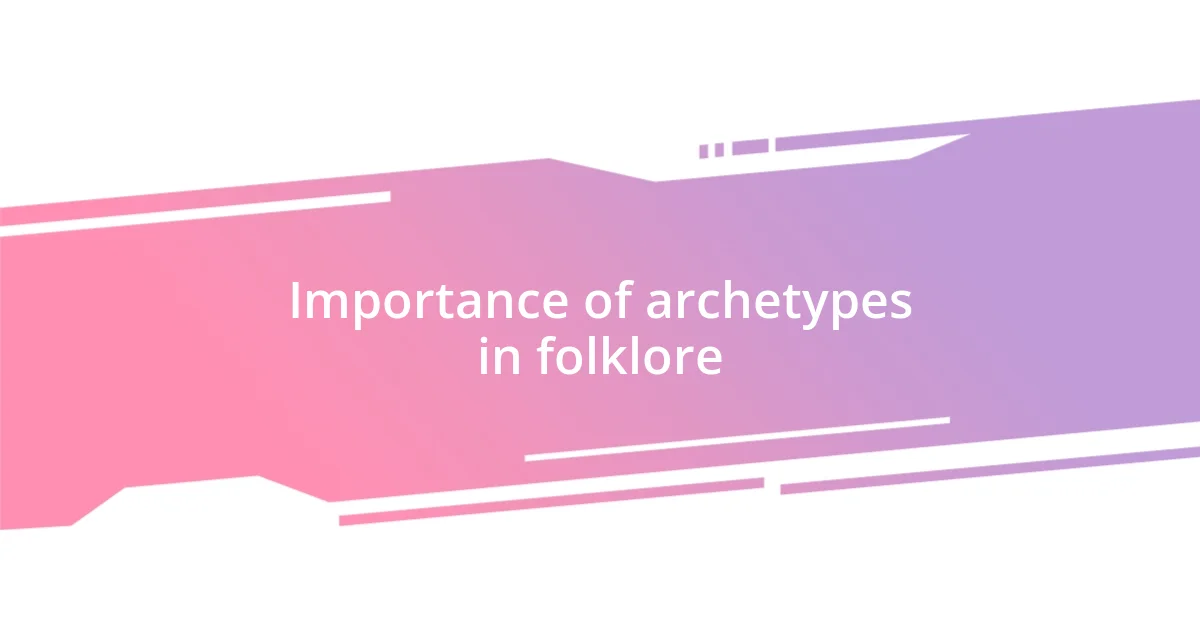Key takeaways:
- Character archetypes serve as universal patterns in storytelling, helping audiences connect across cultures and reflect on personal experiences.
- Transformations of archetypes reveal societal shifts and personal growth, illustrating the complexity of human nature and emphasizing valuable life lessons.
- Integrating diverse archetypes in modern narratives enhances relatability and authenticity, allowing characters to embody the complexities of real-life relationships and experiences.

Understanding character archetypes
Character archetypes serve as universal patterns in storytelling, resonating with audiences across cultures and time. I remember first realizing this while diving into classic tales, where certain characters felt oddly familiar despite being from entirely different backgrounds. Isn’t it fascinating how the hero, the mentor, or the trickster seem to pop up in various narratives, almost like old friends who share similarities in their struggles and triumphs?
These archetypes act as a framework, guiding both writers and readers through the complexities of a story. I often ponder how they shape our understanding of human experience and emotion. For instance, think about the wise old sage—how many times have we looked for guidance in our own lives from someone who embodies that archetype? Their presence in folklore reminds us of the wisdom we can glean from others, creating connections that transcend generations.
As I explore these character types, I can’t help but feel a sense of nostalgia. Each archetype holds a mirror to our own experiences, inviting us to reflect on our roles in the narratives of our lives. When you encounter these familiar figures in a story, don’t you feel a tug at your heartstrings, as if they’re revealing deep truths about who we are? Engaging with these archetypes allows us to better understand ourselves and the collective human journey we all share.

Importance of archetypes in folklore
Character archetypes in folklore serve as a vital link between stories and the human condition, grounding us in shared experiences. I remember reading a folktale about a clever trickster and being reminded of a friend who always knew how to diffuse tension with humor and wit. This connection makes it clear that archetypes don’t just populate stories; they resonate deeply with real-life experiences that shape who we are and how we relate to others.
In many ways, these archetypes offer a language of their own—one that spans generations and cultures. When I hear a story featuring the courageous hero, it sparks memories of my childhood, like the time I faced a daunting challenge. The emotional journey of those characters often mirrors my own, making these tales feel profoundly personal. This shared narrative thread fosters a sense of community among listeners, bringing us together regardless of our backgrounds.
Archetypes also serve as touchstones for moral and ethical lessons, blending entertainment with valuable insights. I often find myself reflecting on the lessons imparted through the wise old mentor or the treacherous villain. These characters compel us to think critically about our choices and behaviors, enabling the folklore to serve as more than mere stories—they’re blueprints for navigating the complexities of life.
| Archetype | Importance |
|---|---|
| Hero | Embodies courage and resilience |
| Trickster | Challenges the status quo and brings humor |
| Mentor | Provides wisdom and guidance |
| Villain | Represents moral challenges and conflict |

Common archetypes in global folklore
Common archetypes appear throughout global folklore, transcending cultural boundaries and echoing shared human experiences. As I recall my childhood visits to different cultural festivals, it became clear to me that regardless of the setting, I could always spot the cunning trickster or the steadfast hero. It’s incredible how these characters, often rooted in our collective psyche, serve as a way for us to connect across time and geography.
Here are some of the most prevalent archetypes in folklore:
- The Hero: The champion who faces adversity and overcomes significant obstacles.
- The Wise Old Sage: Often a source of wisdom and guidance, helping others navigate life’s challenges.
- The Trickster: This playful character disrupts norms, teaching lessons through humor and cunning.
- The Villain: A representation of fear and moral complexity, they compel protagonists to confront their inner demons.
- The Innocent: Typically a pure-hearted character who brings out the goodness in others, often in dire situations.
I find it fascinating how these archetypes make stories relatable. For example, when I came across a tale featuring a stubborn hero who refused to back down, I couldn’t help but reflect on my own experiences of perseverance. It’s as if these stories are not just meant to entertain; they invite us to examine our lives through the lens of these characters, weaving our own narratives in the process.

Application of archetypes in storytelling
Archetypes in storytelling are not just templates; they are powerful vessels for themes and emotions that resonate deeply within us. I recall reading a fairy tale where the underdog triumphed against overwhelming odds. It stirred something inside me, prompting me to think about my own struggles and the times I’ve felt small in a big world. This personal connection transforms a simple narrative into a profound experience, allowing us to explore our own fears and aspirations through the lens of familiar characters.
When I consider the role of the mentor archetype, I think back to my days in school. There was a teacher who took an interest in my ideas and gently guided me through challenges. Much like the wise sages in folklore, her support made me see that the lessons imparted through storytelling are often reflections of our own journeys. Don’t you find it remarkable that characters like these can illuminate paths we never knew were available to us?
Moreover, archetypes can drive the emotional stakes in a story, engaging us in ways that feel instinctual. For instance, the villain often embodies the darkest parts of ourselves—those intrusive thoughts that whisper we’re not good enough. When I encountered a villain who mirrored my own self-doubt, it forced me to confront those feelings head-on. Isn’t it interesting how these archetypes compel us to not only reflect on the narratives but also to engage directly with our inner conflicts? They act as mirrors, pushing us to seek our own resolutions in the stories we tell.

Analyzing archetype transformations
Transformations in archetypes reveal much about societal shifts and personal growth. I remember reading a modern adaptation of a classic fairy tale where the once villainous queen became a sympathetic character. This transformation made me reflect on how people can change with circumstances and how our perceptions often evolve, casting old narratives in a different light. Have you ever found yourself re-evaluating someone you thought you knew? It’s fascinating how storytelling mirrors our understanding of human complexities.
In folklore, the hero’s journey often involves significant growth, mirroring our life experiences. Once, I encountered a story that depicted a hero who initially sought glory but eventually recognized the importance of community and compassion. Watching that character transform made me think of my own experiences where ambition blinded me to the value of teamwork. Isn’t it interesting how we often need a narrative to remind us of these lessons? The transformation of archetypes not only enriches the story but also resonates deeply with our personal journeys.
Examining the evolution of the trickster archetype, I can’t help but recall how this character’s mischief often serves to expose societal flaws. I once read a tale where the trickster was reimagined as an instigator of positive change rather than just chaos. This shift challenged my perception and highlighted how adaptability can lead to innovation. Have you ever thought about how the roles we assign to others can limit our understanding of their potential? By analyzing these transformations, we can appreciate the multifaceted nature of every character, which encourages us to embrace complexity in our own lives.

Creating unique characters using archetypes
Creating unique characters using archetypes opens a world of possibilities. When I first started weaving my own stories, I struggled with making my characters stand out. One day, I decided to take the basic hero archetype and infuse it with traits from the caregiver archetype, resulting in a hero who not only faced challenges but also nurtured others along the way. This blend taught me that even familiar patterns can yield fresh and memorable personalities.
I think of one character I developed—a rogue knight who initially embodied the classic hero but revealed a deep vulnerability. By incorporating elements of the shadow archetype, I allowed him to confront his fears and guilt over his past decisions. Have you ever wondered how our own insecurities shape our actions? This exploration helped me create a character who resonated not just with bravery, but also with the complexities of regret and redemption.
Also, consider the dynamics when blending two archetypes, like the sage and the jester. I once crafted a character who dispensed wisdom through humor, making serious life lessons approachable. This experience taught me the importance of balancing depth with relatability. Isn’t it remarkable how humor can disarm us and reveal profound truths? By carefully combining archetypes, we can breathe life into our characters, ensuring they not only exist in a story but also linger in the hearts and minds of our readers.

Integrating archetypes into modern narratives
Integrating archetypes into modern narratives can lead to rich storytelling that resonates with audiences on multiple levels. I remember when I watched a film that reinterpreted the classic mentor archetype as a reluctant guide. The character, who initially seemed disinterested, unveiled layers of depth that mirrored the struggles of many who teach us through life’s experiences. This made me think—how often do we overlook those who possess wisdom just because they’re not the traditional, wise old figures we expect?
I once tried my hand at crafting a story featuring the lover archetype, but instead of following the predictable path of romance, I made the character also embody the rebel. This combination showcased a journey marked by both passion and defiance, reflecting my belief that love can inspire us to challenge societal norms. Isn’t it liberating to imagine love as a force of rebellion? Merging archetypes like this not only enhances the narrative but also allows readers to connect with characters who mirror the complexities of real-life relationships.
One of my favorite attempts at blending archetypes was creating a character who simultaneously represented the innocent and the wise fool. This character navigated naïveté alongside bursts of unexpected insight, embodying the idea that wisdom often comes from an unfiltered perspective on life. I found that this approach helped me reflect on my own misconceptions; isn’t it true that sometimes, the purest views yield the most profound truths? Integrating diverse archetypes into modern stories can therefore illuminate the nuances of human experience, making every character feel more relatable and authentic.














